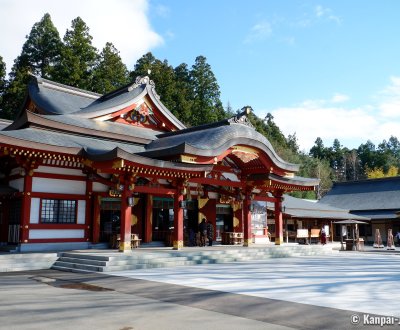Morioka Hachiman-gu
Iwate’s Great Shrine
Morioka Hachiman-gu is a Shinto shrine in the heart of Morioka City, in Iwate prefecture, in the north of Japan. All year round, several very popular matsuri festivals take place amidst its imposing pavilions and large enclosure.
Morioka Hachiman-gu is said to have its origins back to 1062 with the Minamoto Clan when they were battling the Abe clan in the Zenkunen war at the time. A first shrine called Hatomori Hachiman-gu was then erected to pray for the victory of Minamoto’s army.
In 1680, the daimyo lord of Morioka domain, Nanbu Shigenobu (1616 - 1702), has it reconstructed. The Shinto enclosure was thereafter destructed and relocated several times after natural disasters and fires 🔥. Today’s buildings have a modern aspect, as they were renovated in 1997 and the main great torii ⛩️ gate was built in 2002.
Thanks to its impressive size and its bright red vermilion, it is viewable from afar, especially from the starting point of the Hachiman-dori avenue that leads to the grounds’ entrance. The 850 meters straight street is lined with small local shops, restaurants and cafés, an ideal setup to wander in before visiting the shrine.

An enclosure of sumptuous dimensions
Located in Morioka city center, Hachiman-gu shrine enjoys a large superficy, noticeable as soon as entering the premises. The installations are spacious and large. There are all the usual structures of a Shinto site, such as:
- Sando, the central paved path;
- Chozuya, the ablution pavilion to purify before praying;
- The pair of komainu guardians, represented by 2 massive stone statues;
- Ishidan, the stone stairway leading to the main plaza; and,
- Haiden and honden, the cultual pavilions richly decorated with sculptures dedicated to the kami Hachiman, the god of war enshrined here.
The enclosure is also home to several other smaller pavilions such as:
- The one dedicated to Daikokuten and Ebisu, 2 of the Lucky Gods in Japan, often pictured together and related to commercial and agricultural wealth;
- Takabe-jinja, dedicated to a cooking deity;
- Morioka Ten-jinja for academic success;
- En-musubi-jinja to find one’s soul mate and have good love relationships; and,
- Iwate Gokoku-jinja, the prefectural shrine dedicated to the soldiers fallen for the country.
Overall, about a dozen of secondary shrines with distinctive functions are gathered in the same enclosure. All of them are good reasons for Morioka’s inhabitants to go pray at Hachiman-gu. In addition, the place is really popular for traditional Shinto wedding ceremonies, as well as all yearly family celebrations.

Regional matsuri renowned throughout Japan
Morioka Hachimangu is also widely known in the archipelago for its popular matsuri festivals that take place each year, especially:
- Morioka Aki Matsuri, held in September, is famous for its marvelous float procession and yabusame (horseback archery) festival;
- Chagu Chagu Umakko, takes place on the 2nd Saturday of June, with a parade of horses and their horsemen donning beautiful traditional costumes, going to the shrine as it is the arrival destination of a horse transhumance. The horses are carrying bells whose tinkling is enlisted in the 100 Soundscapes of Japan.
The place may sometimes seem empty, especially on a week day, but Hachiman-gu shrine is a major place of gathering for the local population. It is therefore a good destination for sightseeing travelers wishing to immerse shortly in the Shinto rituals rooted in the every day life. The visit continues nearby with the discovery of Morioka Castle 🏯’s ruins, converted in a pleasant public park with abundant cherry trees 🌸 blooming in spring.

